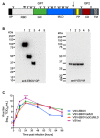Ebola Virus Glycoprotein Domains Associated with Protective Efficacy
- PMID: 34200548
- PMCID: PMC8229685
- DOI: 10.3390/vaccines9060630
Ebola Virus Glycoprotein Domains Associated with Protective Efficacy
Abstract
Ebola virus (EBOV) is the cause of sporadic outbreaks of human hemorrhagic disease in Africa, and the best-characterized virus in the filovirus family. The West African epidemic accelerated the clinical development of vaccines and therapeutics, leading to licensure of vaccines and antibody-based therapeutics for human use in recent years. The most widely used vaccine is based on vesicular stomatitis virus (VSV) expressing the EBOV glycoprotein (GP) (VSV-EBOV). Due to its favorable immune cell targeting, this vaccine has also been used as a base vector for the development of second generation VSV-based vaccines against Influenza, Nipah, and Zika viruses. However, in these situations, it may be beneficial if the immunogenicity against EBOV GP is minimized to induce a better protective immune response against the other foreign immunogen. Here, we analyzed if EBOV GP can be truncated to be less immunogenic, yet still able to drive replication of the vaccine vector. We found that the EBOV GP glycan cap and the mucin-like domain are both dispensable for VSV-EBOV replication. The glycan cap, however, appears critical for mediating a protective immune response against lethal EBOV challenge in mice.
Keywords: EBOV; VSV; filovirus; glycan cap; mucin-like domain; vesicular stomatitis virus.
Conflict of interest statement
H.F. claims intellectual property regarding the vesicular stomatitis virus-based filovirus vaccines. All other authors declare no conflict of interest.
Figures



References
-
- WHO . Ebola Situation Report. World Health Organization; Geneva, Switzerland: 2016.
Grants and funding
LinkOut - more resources
Full Text Sources
Miscellaneous

